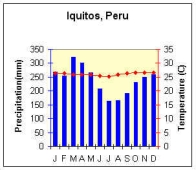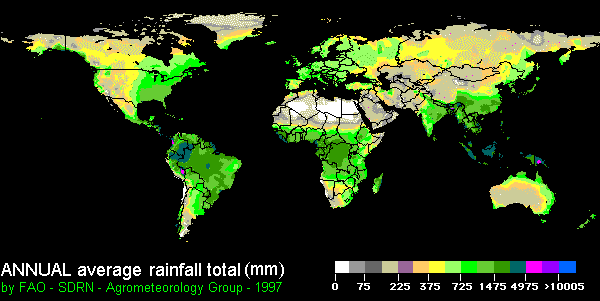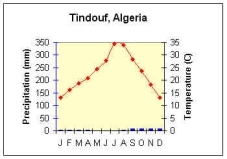The equator to the subtropicsIn general, precipitation decreases poleward away from the equator as one moves toward the subtropical regions. The largest annual precipitation totals straddle the equator while the driest regions on Earth lie near the Tropic of Cancer. In addition, precipitation becomes more seasonal as one moves away from the Equator. This is primarily due to the shifting locations of global wind and pressure systems. Figure 7.36 Climograph for Iquitos, Peru Climates straddling the equator
experience some of the
highest annual precipitation amounts of all climates on Earth. This is
depicted by the blue bar graph in the climograph for Iquitos, Peru located at 3oS
Figure 7.37 Annual Average Rainfall
Moving poleward, precipitation becomes more seasonal. In the tropics (10o - 23.5o) the maximum amount of precipitation falls during the high sun (summer) season. During the summer, the ITCZ shifts poleward bringing precipitation with it. As the Sun's most intense rays shift equatorward during the low sun season, the ITCZ moves out of the region and a dry season sets in. The length and intensity of the dry season tends to increase toward the poleward limits of the tropics.
Depending on location, the subtropics (23.5o-
35o) can be very
dry or wet. The equatorward side of the subtropics tends to be quite
dry. As one moves poleward the amount of precipitation increases though
has a seasonal character. Within the continental interior of Africa at about 23.5o
N the
great Sahara Desert can be found. These conditions are represented in
the climograph for Tindouf, Algeria But when you move to the poleward limits of the subtropics, especially on the east coast of a continent, annual precipitation increases. The increase in precipitation in these regions is due to the presence of moist mTu air masses that blow onshore. As they come on shore, convection lifts the air to promote cooling, condensation, and precipitation. In addition, the poleward limits of the subtropics border the midlatitudes where polar front cyclones produce precipitation. |



